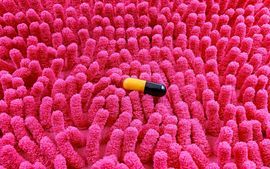- Published:
- 16 October 2025
- Author:
- Dr Aiman Haider
- Read time:
- 7 Mins
Dr Aiman Haider reflects on the College response to the Men’s Health Strategy for England and the crucial role histopathologists have in the context of workforce shortages. Dr Haider highlights some of the recent studies that have influenced practice changes for the benefit of men’s health.
"The College response to the Men’s Health Strategy very accurately concludes pathologists are vital not only for diagnosis but for guiding risk-stratified management. Their workload must be respected and supported with staffing, technology and training. A future of smarter screening, better biopsy strategies and AI-augmented diagnosis holds promise – if implemented with care".1
In this article, I will further explain how crucial histopathology is to the crux of patient care and management, and the urgent need to secure expert training and staffing.
Sir William Osler wrote: "The good physician treats the disease; the great physician treats the patient who has the disease." This is the very essence of personalised medicine, focused on assigning the right diagnosis to the right patient at the right time for appropriate management.
Therefore, in this new era of personalised medicine, histopathology input is important and affects the clinical implications and quality of research results. Effective and efficient multidisciplinary working helps facilitate effective clinical pathways and decision-making, fostering high-quality collaborative working on translational research and interventional trials that need pathology input for validation.
As Professor Berney highlights in the College response,2 it is time to recognise that staffing resource has to be respected and protected. Without this, any advances in the science and delivery of management cannot occur.The last decade has seen colossal changes in clinical management and practice with regard to prostate cancer, as a result of practice-changing trials. In this article, I summarise a few of the multidisciplinary multicentre trials that have brought about practice change and made a difference to men’s health.
PROMIS
PROMIS is a National Institute for Health and Care Research-funded, non-randomised study that investigated whether multiparametric magnetic resonance imaging (mpMRI) could be used to advise whether or not men might safely avoid biopsy, and to help us do better biopsies for men who need them.3 This multicentre trial recruited 740 men. All pathology was centrally reviewed for quality assurance.
The trial demonstrated that mpMRI is a highly sensitive test (93%) and is cost-effective for the detection of clinically significant cancer. If performed prior to the biopsy, it can identify the approximately 25% of men who might safely avoid a biopsy.
A unique dataset of patient data, including digitised biopsies, from this trial gave way to numerous new studies and projects exploring digital evaluation of prostate biopsies and secondary analysis and follow-up.4,5
PRECISION
The PRECISION trial is a landmark, international multicentre randomised controlled trial, in which 500 men were randomised to compare the standard 12-core TRUS biopsy against mpMRI.6 The study was published in the New England Journal of Medicine and was awarded the Fritz Schröder EAU Prostate Cancer Research Award in 2019 and UK Research Paper of the Year at the 2019 BMJ awards.
The histology for all cases recruited to the trial were centrally reviewed at University College London Hospitals. The results of this trial led to the introduction of formal guidance published by the National Institute for Health and Care Excellence, which approved mpMRI as a first-line investigation for men suspected of having clinically localised prostate cancer.
PEOPLE
The PEOPLE (PatiEnt prOstate samPLes for rEsearch) trial was a multidisciplinary collaboration to collect high-quality fresh tissue for research use, using MRI and biopsy data to target areas of tumour and benign tissue.7 It brought together a huge team of surgeons, nurses, computational experts, molecular biology scientists, theatre staff, nurses and histopathologists for fresh tissue sampling. The data supported the 100,000 Genome Project and a variety of other translational research projects.
NeuroSAFE PROOF
The NeuroSAFE PROOF study was a multicentre, patient-blinded, randomised controlled Phase III trial that took place at 5 NHS hospitals, recruiting 407 participants.8,9
The study demonstrated that, compared with participants undergoing standard radical prostatectomy, participants undergoing a nerve-sparing procedure guided by the NeuroSAFE technique had a significant improvement in patient-reported erectile function scores and early urinary continence scores. The trial also recognised that difficulties in recruitment and execution were hugely attributable to shortage of staff and support to histopathology staff in a resource-limited environment.
PRIME
The recently published PRIME trial establishes evidence that biparametric MRI, a faster and less costly technique, is non-inferior to mpMRI.10 The study determined that biparametric MRI may serve as a new global standard for prostate cancer diagnosis, offering significant gains in efficiency and health system capacity. During the trial, the histopathology of all sites was double reported for quality check and quality assurance.These are just a few examples of prostate cancer studies that required significant pathology input and led to changes in clinical practice. Other studies, such as RECONCILE and LIMIT, are looking to improve imaging modalities and early detection.
The pilot phase of the biggest prostate cancer screening trial, TRANSFORM, is in progress; it aims to detect the best possible way of screening men with prostate cancer. The central review and validation of pathology reports and results provides a high-quality control and quality assurance for the trials to succeed.
The story doesn’t end with prostate cancer. Rare genitourinary tract cancers, including penile, testicular and bladder cancers, need a niche subset of uropathologists to cater to the pathology pathways and enable high-quality management.Sir William Osler also wrote: "The pathologist is the doctor’s doctor." We need recognition by managerial structures that expert and specialist-led training and recruitment are crucial, in addition to adequate staffing and resource support. With the current shortage of staff, the capacity to keep the clinical service afloat is a challenge that most teams across the country face – let alone finding time to support teaching, training and academia.
Many specialist uropathology teams find expert recruitment difficult, as this is a busy speciality that demands laborious work with specimens and reporting, and caters to large workload volumes. In addition to creating the necessary consultant body to provide this service, researchers should liaise with expert-led teams to generate subspecialist training opportunities and speciality fellowship schemes to attract the next generation.
This narrative is a call for leaders to urgently help formulate the solutions that Professor Berney has highlighted in the College response. The clinical pathway must have adequate staffing, workforce, technology and support, so that histopathologists can contribute to the visionary growth and transformation that the Men’s Health Strategy calls for.
References available on our website.


